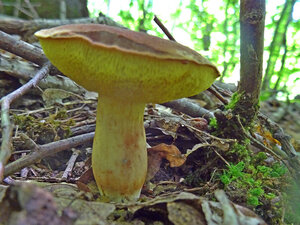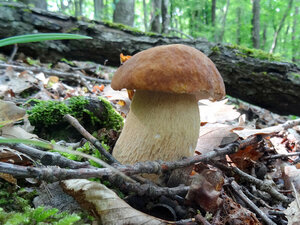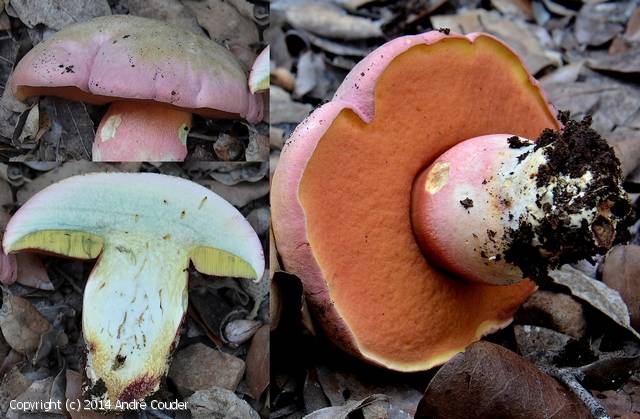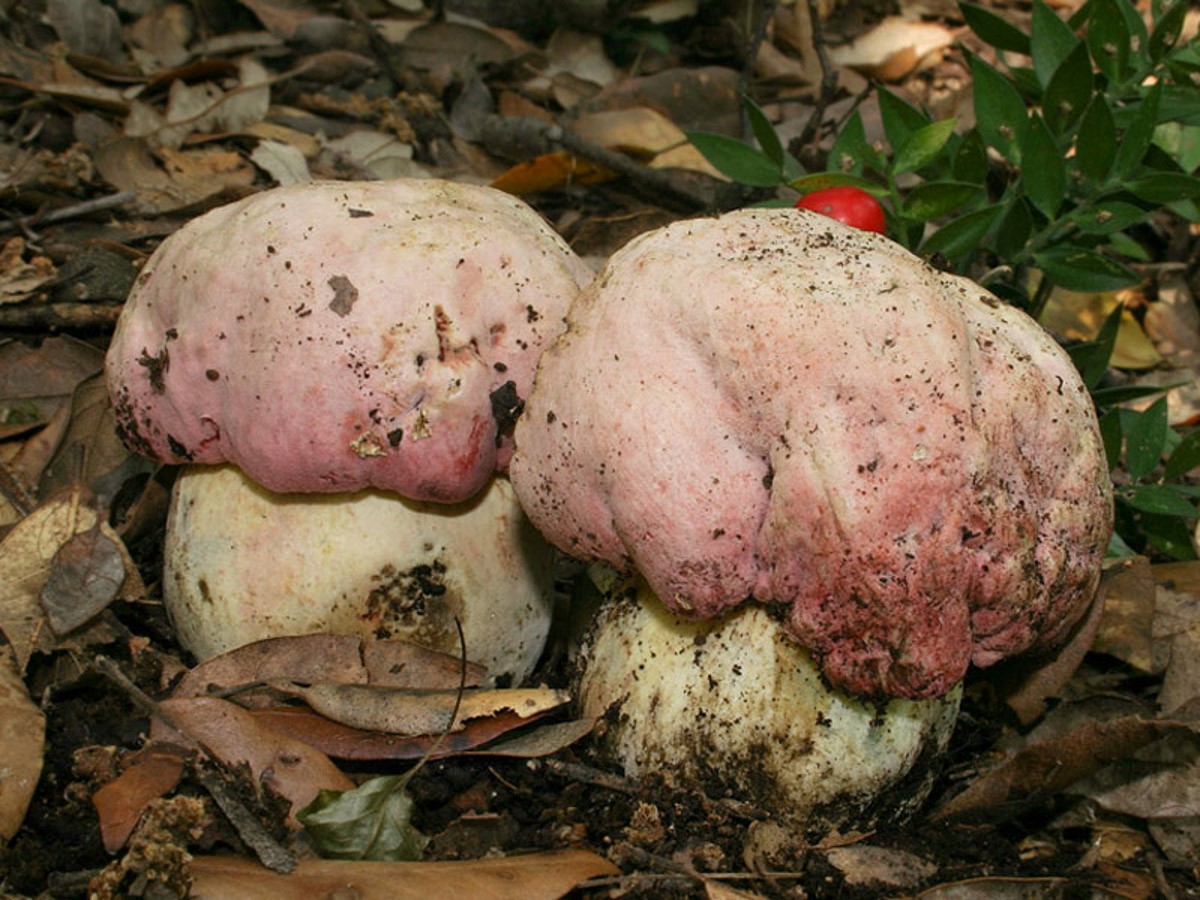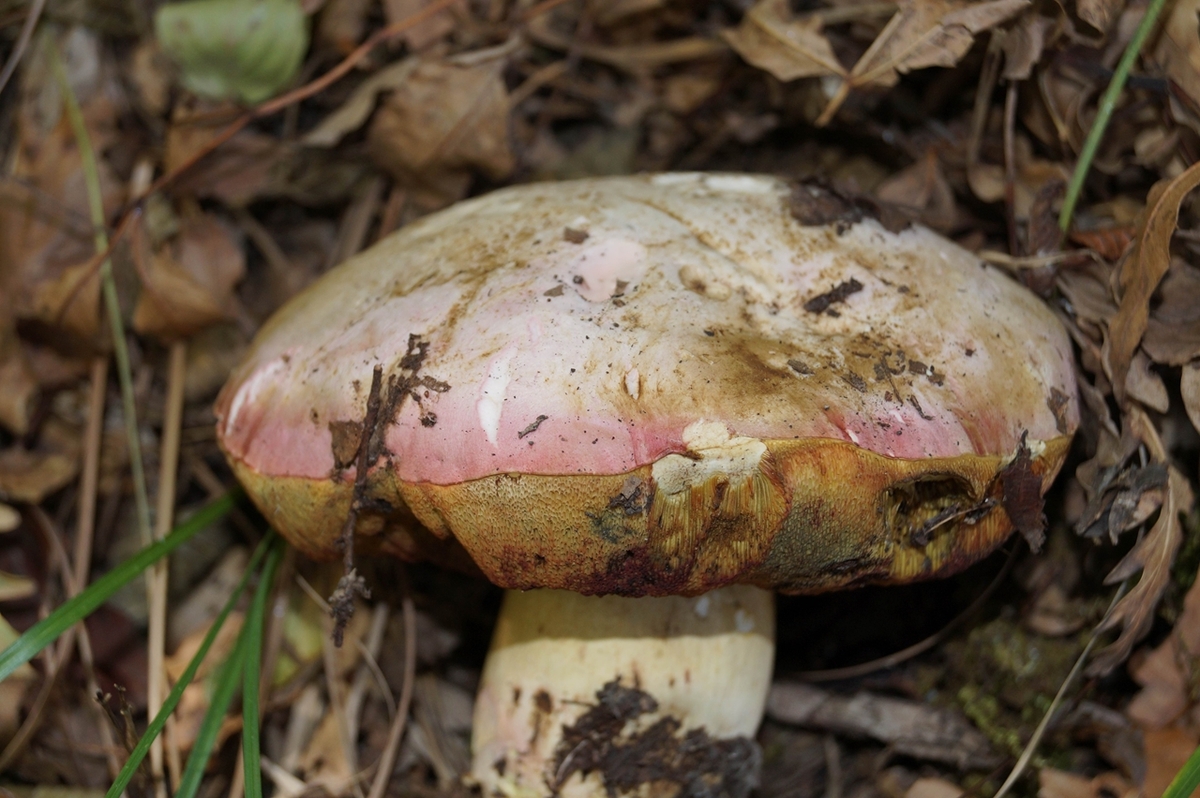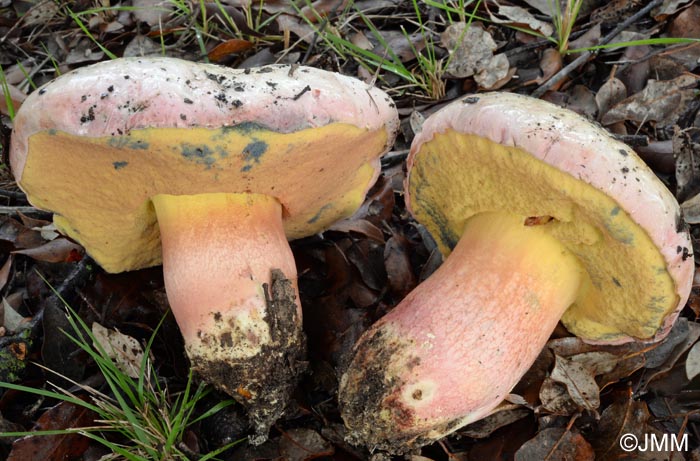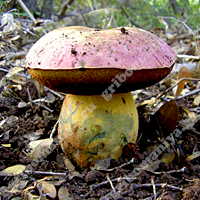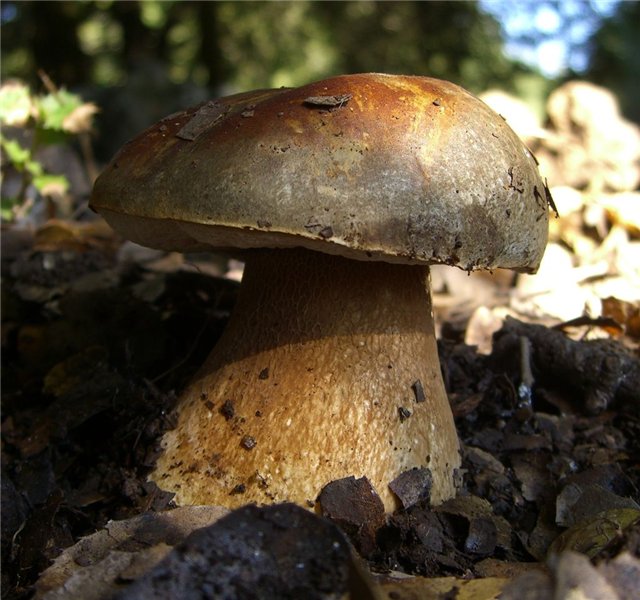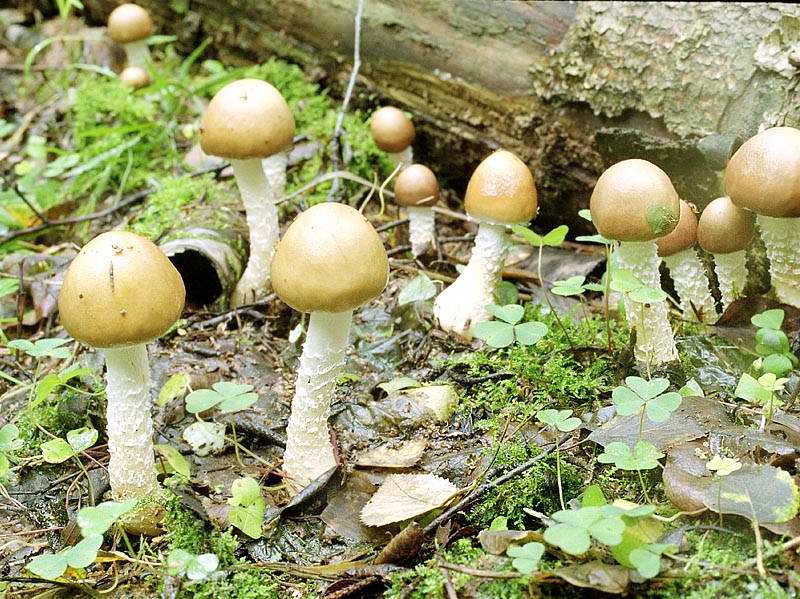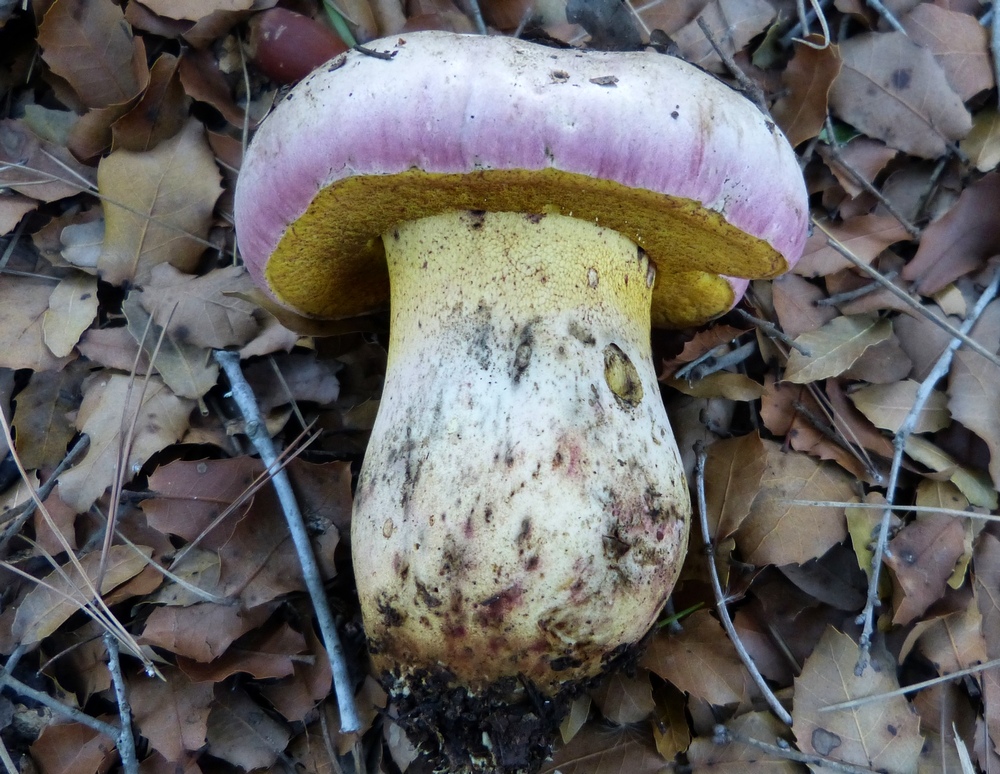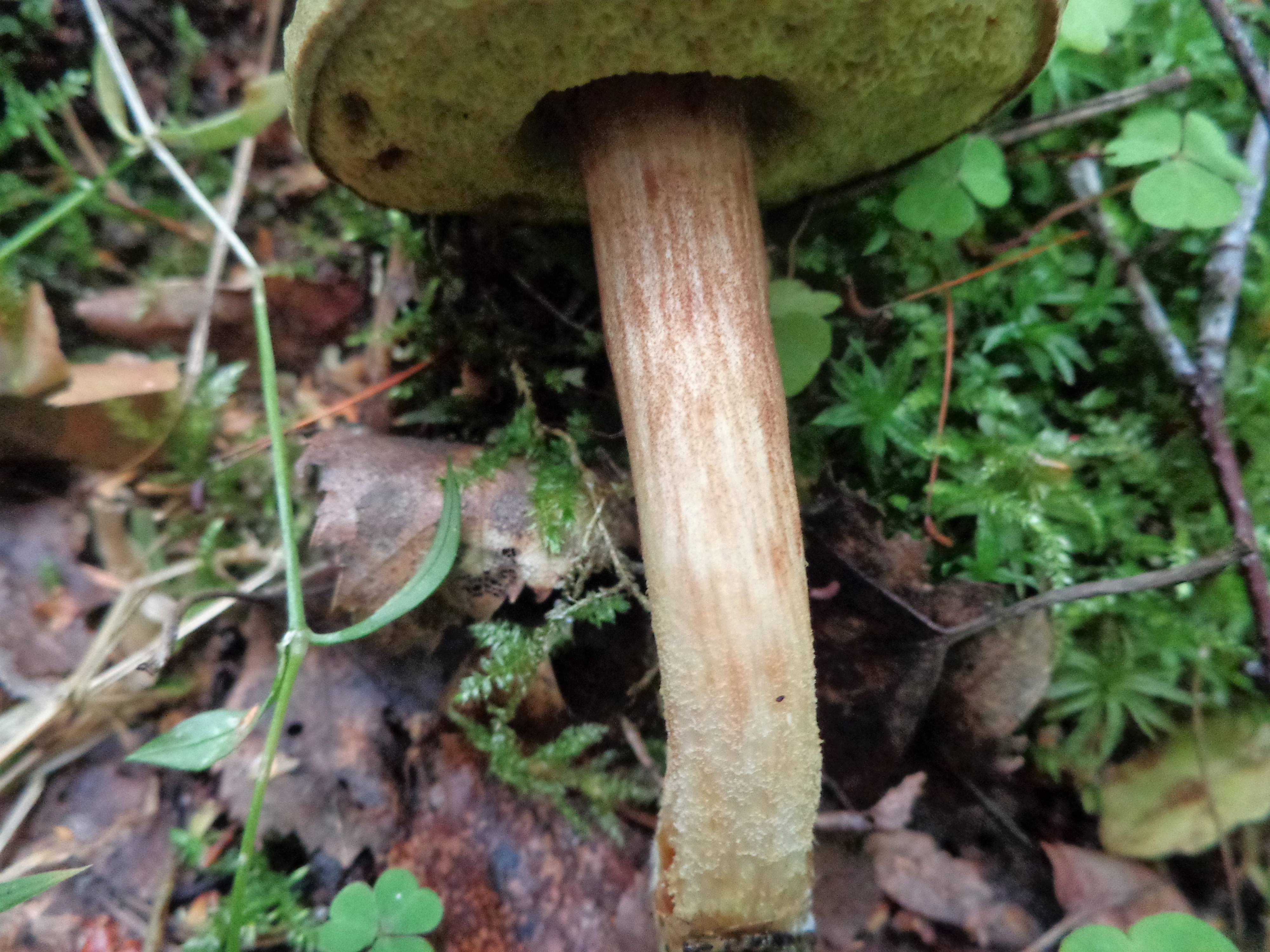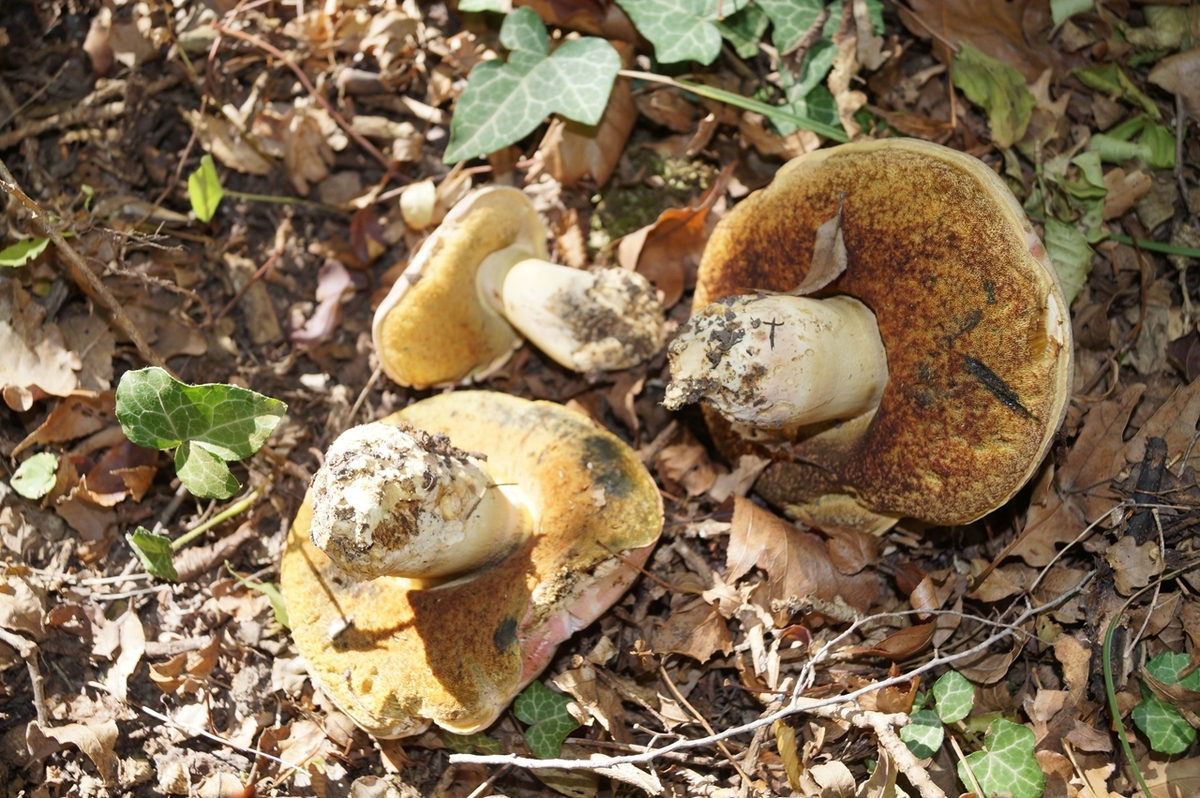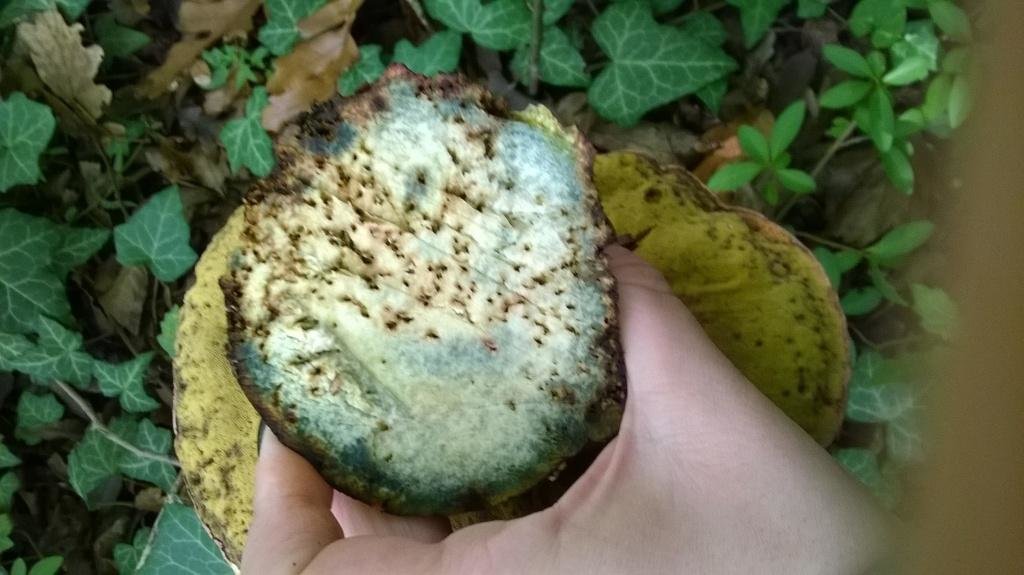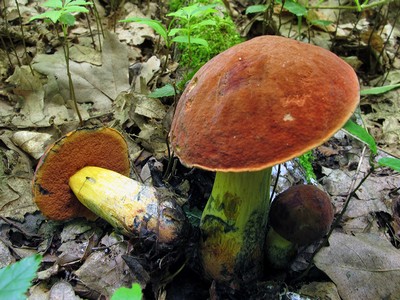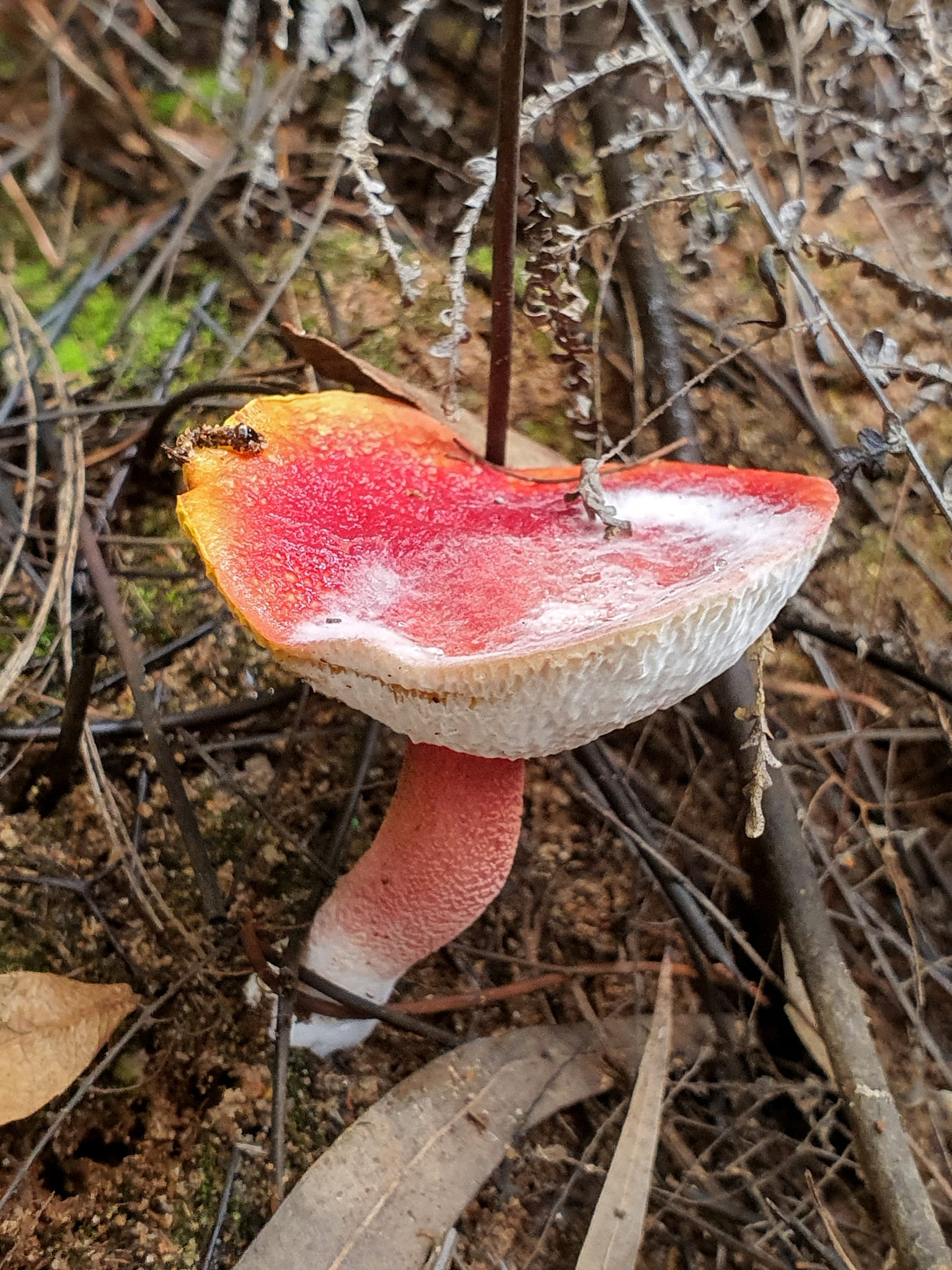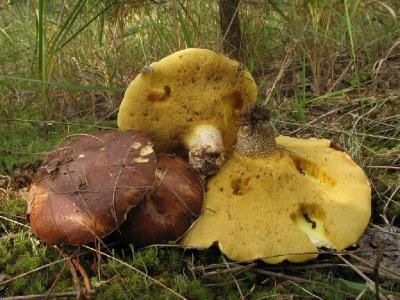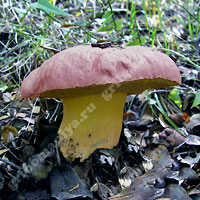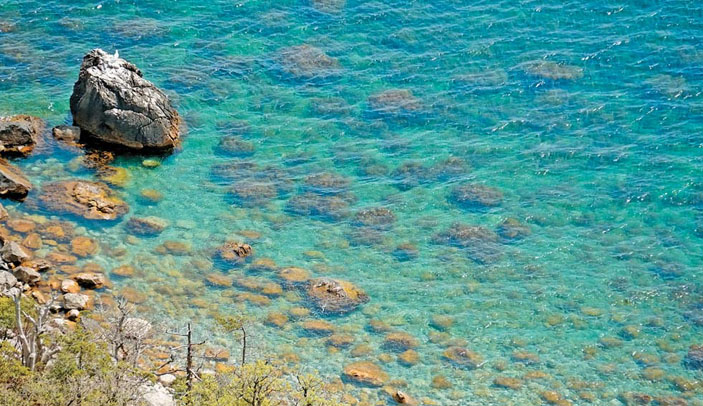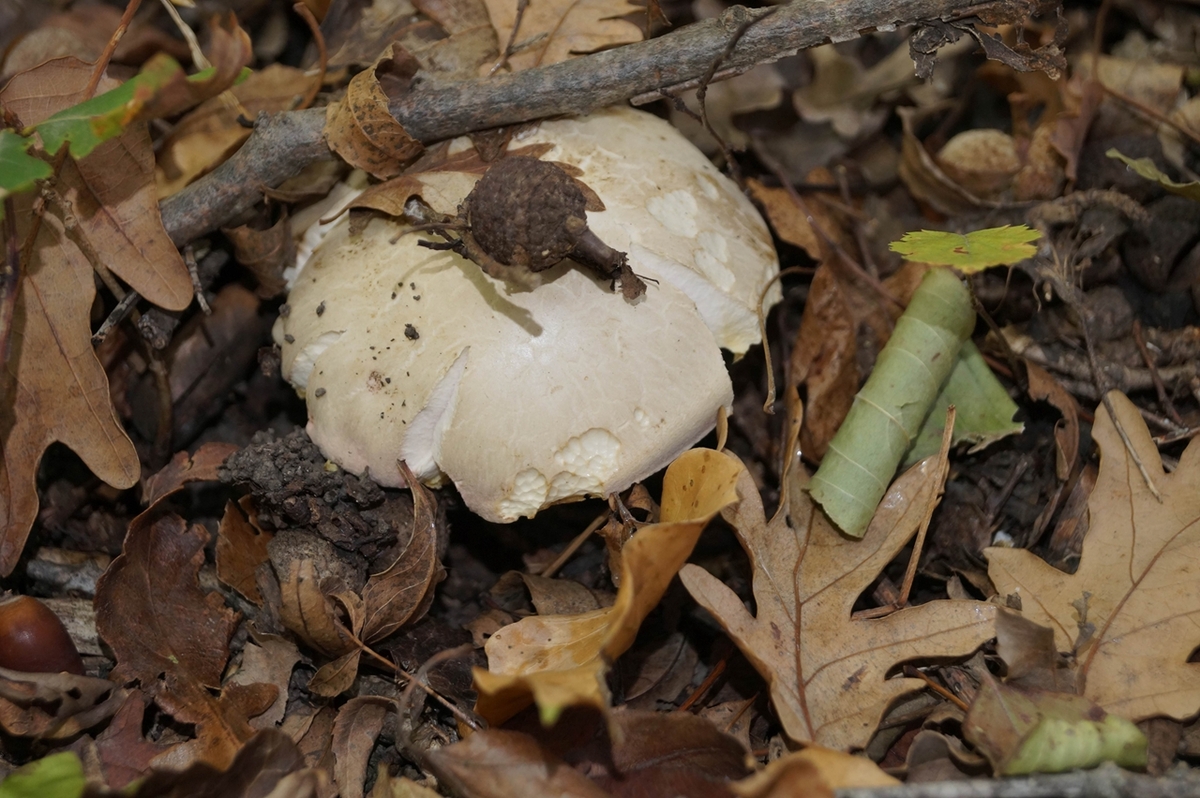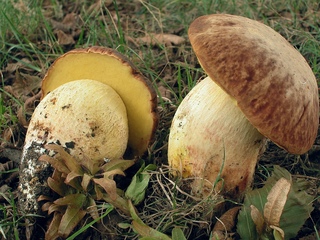Golden boletus (Aureoboletus projectellus)
Synonyms:
- Boletellus projectellus
- Ceriomyces projectellus
- Boletellus murrill
- Boletus heather

Previously considered a widespread American species from Canada to Mexico. However, in recent decades, it has been confidently conquering Europe.
In Lithuania they are called balsevičiukai. The name comes from the name of the forester Balsevičius, who was the first in Lithuania to find this mushroom and taste it. The mushroom turned out to be delicious and became famous in the country. It is believed that these mushrooms appeared on the Curonian Spit about 35-40 years ago.
Description
Hat: 3-12 centimeters in diameter (some sources indicate up to 20), convex, sometimes with age it becomes widely convex or almost flat. Dry, finely velvety or smooth, often cracking with age. The color is reddish brown to purplish brown or brown, with a sterile edge - overhanging skin, "projecting" = "overhang, droop, protrude", this feature gave the name to the species.
Hymenophore: tubular (porous). Often depressed around the stem. Yellow to olive yellow. Does not change or almost does not change color when pressed, if it does, then not blue, but yellow. The pores are round, large - 1-2 mm in diameter in adult mushrooms, tubules up to 2.5 cm deep.
Leg: 7-15, up to 24 centimeters high and 1-2 cm thick. May be slightly tapered at the top. Dense, elastic. Light, yellowish, with age, the yellow intensifies and appears reddish, brown shades, becomes brownish-yellowish or reddish, close to the color of the cap. The main feature of the Golden Boletus leg is a very characteristic ribbed, mesh pattern, with well-defined longitudinal lines. The pattern is clearer in the upper half of the leg. At the base of the peduncle, a white mycelium is usually clearly visible. The surface of the stem is dry, sticky in very young mushrooms or in wet weather.

Spore powder: olive brown. Spores: 18-33 x 7.5-12 microns, smooth, flowing. Reaction: gold in KOH.
Flesh: firm. Light, whitish-pinkish or whitish-yellowish, does not change color at the cut and break, or changes very slowly, acquires a brownish, brownish-olive tint.
Chemical reactions: Ammonia - negative for cap and pulp. KOH - negative for cap and pulp. Iron salts: dull olive on the cap, grayish on the flesh.
Smell and taste: subtle. According to some sources, the taste is sour.
Edibility
Edible mushroom. Lithuanian mushroom pickers claim that golden boletus is inferior to ordinary Lithuanian boletus in taste, but they are attracted by the fact that they are rarely wormy and grow in accessible places.
The fungus forms mycorrhiza with pine trees.
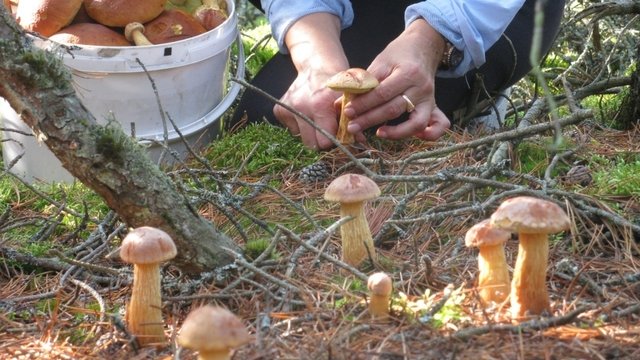
Season and distribution
Grow singly or in small groups in summer and autumn. In Europe, this mushroom is very rare. The main region of golden boletus is North America (USA, Mexico, Canada), Taiwan. In Europe, golden boletus is found mainly in Lithuania. There are reports that golden boletus was found in the Kaliningrad and Leningrad regions.
Recently, golden boletus has been found in the Far East - Vladivostok, Primorsky Territory. Apparently, the region of its habitat is much wider than previously thought.
Photo in the article: Igor, in the gallery - from the questions in recognition. Thanks to WikiMush users for the wonderful photos!
What does a mushroom look like?
These are very beautiful and delicious mushrooms. The appearance of the fungus changes depending on the stage of development. You can recognize it by the following distinctive features:
- Hat:
- shape - at an early stage, a convex velvety hemisphere with drooping wavy edges, with the skin tightly attached to the flesh. As it grows, it becomes almost flat and smooth;
- color - cream, pale in the central part, and noticeably turns pink towards the edges;
- Hymenophore:
- shape - tubular (the length of thin tubes is about 25 mm) at an early stage of development, adherent to the stem of the fungus and freer (easily separated from the stem) as it matures. Pores, small in size, round in shape, are later deformed due to the growth of the cap;
- color - yellow, as it develops, it becomes olive. The pores are golden, later yellow-olive, change to blue when pressed.
- Leg - it can be from 3 to 5 cm in diameter, from 5 to 12 cm in height:
- shape - compacted, in the form of a club or cylinder, thick at the initial stage and elongated towards maturity. Most of the surface is distinguished by a pronounced fine mesh pattern;
- the color - like a hat - is golden or yellow at the beginning and discolored as it grows.
- Pulp - has a high density in the first stage of development and becomes soft by maturity:
color - yellow or cream, in the context of the hat is reddish.
Beautifully colored boletus
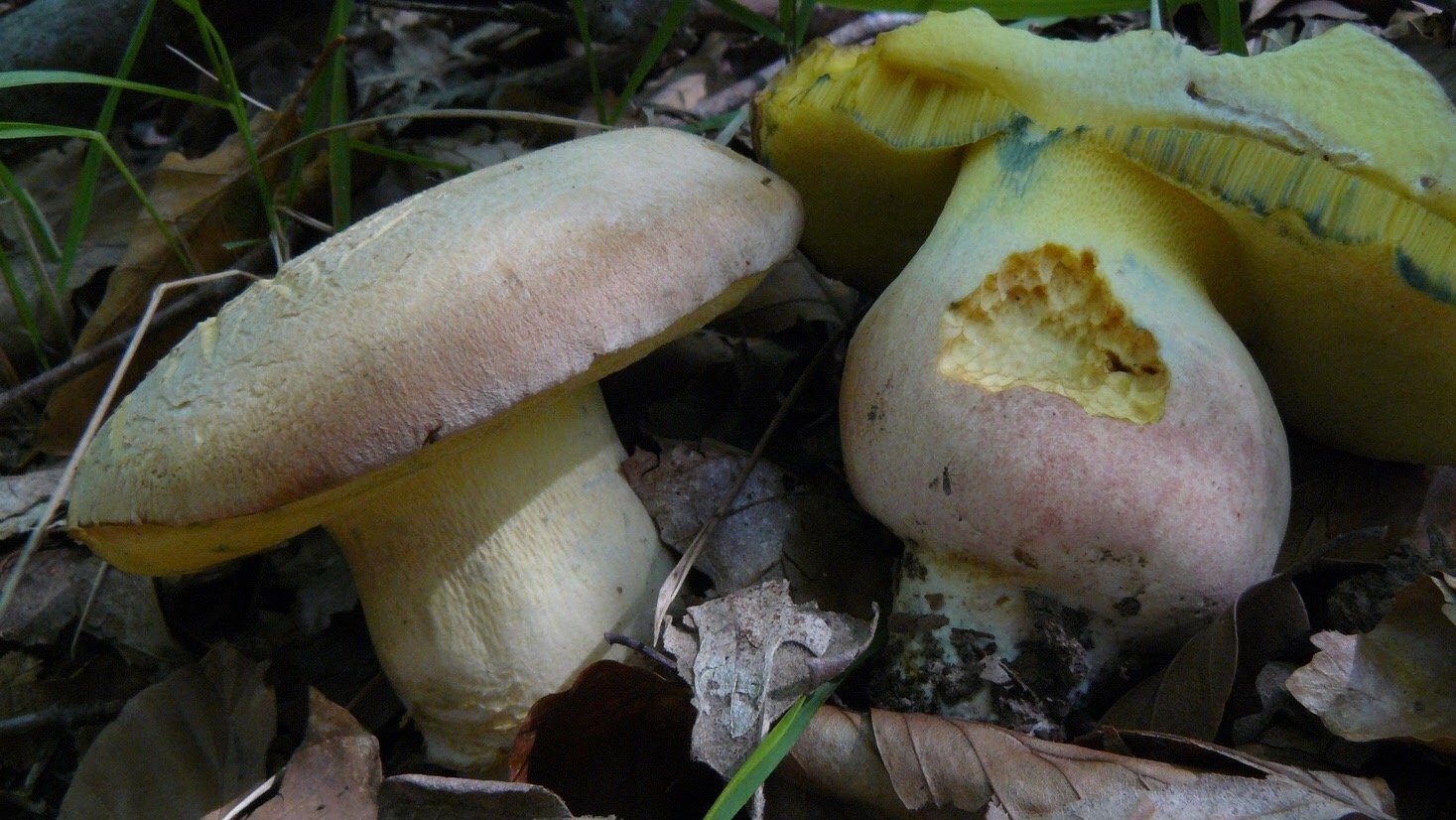
- Beautifully painted bolette
- Boletus pulchrotinctus
- Rubroboletus pulchrotinctus
Description
Hat: 6 to 15 cm in diameter, although may exceed these dimensions, hemispherical at first, gradually smoothing as the mushroom grows. The skin is tightly attached to the flesh and is difficult to separate, slightly fleecy in young specimens and smoother in mature specimens. The color ranges from creamy, paler towards the center, to the characteristic pink shades of this species, very noticeable towards the edge of the cap.
Hymenophore: thin tubes up to 25 mm long, adherent in young mushrooms and semi-free in the most mature ones, easily detached from the pulp, from yellow to olive green. Turn blue when touched. The pores are small, rounded at first, deformed with age, yellow, with orange tints towards the center. When rubbed, they turn blue just like the tubes.
Leg: 5-12 x 3-5 cm dense and firm. In young specimens, it is short and thick, later becoming longer and thinner. At the base it tapers downwards. It has the same tones as the hat (more yellowish in less mature specimens), with the same pink hues, usually in the middle zone, although this may vary. On the surface, it has a fine, narrow mesh that extends to at least the upper two-thirds.
Pulp: firm and compact, which distinguishes this species with a significant specific gravity in relation to other species of the same genus, even in adult specimens. In sheer yellows or creams that change to light blue on cut, especially around the tubes. The youngest specimens have a fruity odor that becomes more unpleasant as the fungus grows.

Spreading
It mainly establishes mycorrhiza with beech trees that grow on limestone soils, especially with the Portuguese oak in the southern regions (Quercus faginea), although it is also associated with rock oak (Quercus petraea) and pedunculate oak (Quercus robur), which prefer siliceous soils. It grows from late summer to late autumn. Thermophilic species associated with warm regions, especially common in the Mediterranean.
Edibility
Poisonous when raw. Edible, low to medium quality when cooked or dried. Unpopular for consumption due to its rarity and toxicity.
Similar species
Due to the described properties, it is difficult to confuse it with other species. Only Suillellus fechtneri shows a more pronounced resemblance due to the pink tones that appear on the peduncle but are absent on the cap. In color, it may still be similar to Rubroboletus Lupinus, but it has orange-red pores and there is no mesh on the stem.
Mushroom photo Beautifully colored boletus from questions in recognition:
Half-bronze bolette: description and photo
| Name: | Semi-bronze bolette |
| Latin name: | Boletus subaereus |
| Type of: | Edible |
| Systematics: |
|
The semi-bronze boletus is a rare mushroom with autumn fruiting. To find him in the forest, you should familiarize yourself with false doubles, study the features of his appearance.
What semi-bronze pains look like
A mushroom with a large cap, reaching up to 17-20 cm in diameter and up to 4 cm thick. In young painters, it is convex, closer in shape to a ball, but as the fruiting body grows, it straightens.
The color of the cap is gray-brown; in adults, yellowish spots appear on it. In dry hot weather, it becomes cracked.
On the underside of the cap, the tubular layer has a white color with a grayish tint. In adult representatives, it changes its color to olive green. The tubules are easily separated from the hat pulp. Their length varies from 20 to 40 mm.
The mushroom rises 12 cm above the ground, the leg reaches 40 mm in thickness. It is dense, thick, outwardly similar to a club or tuber, has a mesh pattern. As it grows, the stem becomes more cylindrical, with a wrinkled surface, pinkish-beige, and then olive-white in color.
Where semi-bronze pains grow
On the territory of the Russian Federation, pain is rare. The main place of its growth is the southern regions, where a predominantly hot climate with a large amount of precipitation. Semi-bronze boletus is more common in moist soils rich in humus.
Fruit bodies are harvested in mixed forests, where oak or beech, pine trees grow. You can find both single semi-bronze bolts and small groups of 2-3 representatives.
Taste qualities of a semi-bronze bolt
The mushroom belongs to delicacies. Gourmets appreciate it for its mild, pleasant taste. According to the comparative characteristics, the semi-bronze ache is more superior in flavor saturation and brightness to the porcini mushroom. The smell of the delicacy is weak, it appears after cooking. The aroma is well felt if the fruit body is dried.
False doubles
The semi-bronze bolt has no exact counterparts. It can be confused with other fruiting bodies in appearance.
A semi-bronze Polish mushroom looks like it hurts: the adult representatives of the species have the same cylindrical stem and a pillow-shaped cap of chocolate or chestnut shades.
To distinguish them, it is necessary to examine the fruit body: in the Polish species, the pulp is white, quickly turns blue under the influence of oxygen.
You can confuse a semi-bronze pain with a bronze boletus. That one is distinguished by a hat of a darker color and the absence of a mesh pattern on the leg.
It should be distinguished from aches and gall fungus. Gorchak has a similar structure, therefore, in order to recognize it, it is necessary to examine the leg. In the gall fungus, it has vascular veins.
Collection rules
When choosing a place, you should explore the mixed forests, visiting them in August-September. The collection point should be located far from highways and industrial facilities.
The collection should be carried out using a sharp knife: carefully cut at the root. It is not recommended to pull out or break off the fruit bodies, the risk of damage to the mycelium is high.
Use
Eating semi-bronze pain is possible in any form, except raw. Housewives, when cooking, after washing, boil the pulp, and then fry or marinate.
You can dry the fruit bodies in order to use them in future recipes.
Mushroom processing principles:
- remove all foliage and small debris from the pulp, cut off the lower part of the fruiting body, rinse under running water;
- place the mushrooms in a bowl of cold water for 15 minutes, then boil it with salt for 20 minutes, if you plan to fry the product, and 40 minutes, if the semi-bronze one hurts, you need to marinate or use it in boiled form.
Conclusion
The semi-bronze boletus is usually classified as edible mushrooms.It has a delicate aroma and mild taste, and is versatile in use. Its main habitat is mixed forests, where it should be distinguished from false species.
Description
Boletus girlish has a typical "painful" structure. Like all boletus mushrooms, this is a large and thick brownish mushroom. The adventitious boletus is a rather rare species.
The boletus boletus cap is predominantly brown, but can also be gray-yellow or reddish-brown. Small boletuses have semicircular caps; with age, their edges open, but the shape remains convex. The hat reaches a size of 20 cm in diameter and more. Its surface is always dry. In young specimens, it is covered with fluff, in old specimens it becomes smooth.
Leg
The adventitious boletus has a greenish-yellow leg, which turns reddish downward. The leg is high and moderately thick (12 * 3 cm in height and in diameter, respectively).
With mechanical action on the leg section, the latter turns blue. The bottom of the leg is pointed. The surface of the legs in young specimens is reticular; with age, the reticularity is smoothed out and becomes invisible.
Spore-bearing layer
The spore layer of the boletus is very thick, represented by tubules. The ends of the tubules (pores) are small and rounded. Young mushrooms have a yellowish tubular layer that turns brown over time. With mechanical action on the hymenophore, it locally changes color to greenish-blue.
Pulp
The inner content of the boletus boletus is represented by an intense yellow pulp, which becomes brown towards the bottom of the leg. When cut, the pulp becomes bluish in color. The taste and aroma are typical for boletus, pleasant.
Spore powder
The spores of the boletus maiden are large individually, resembling an asymmetrical spindle in shape, of a warm yellow hue. The surface of the spores is smooth. In the mass, the powder is greenish-brown.
What does a boletus mushroom look like and its description (+27 photos)
Borovik is a genus of mushrooms of the Boletovye family. Some representatives of this genus have a very high culinary value, so every mushroom picker dreams of putting them in his basket. In order not to treat yourself to a dangerous double instead of a delicacy, it is necessary to carefully study the photo and description of edible mushrooms of the Borovik genus.
Characteristic features of the variety
Representatives of the genus have some individual characteristics by which they can be easily distinguished from other fungi.
The appearance and photo of boletus
Compared to other mushrooms, these look just huge. A large rounded hat is attached to a massive leg thickened at the bottom or in the middle. It is impossible to give a specific description of the color for all species - due to the large species diversity, the color of mushrooms can vary from white to dark brown.

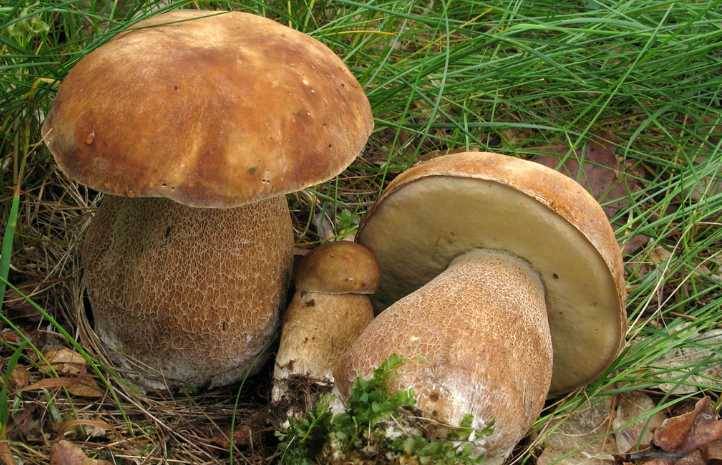

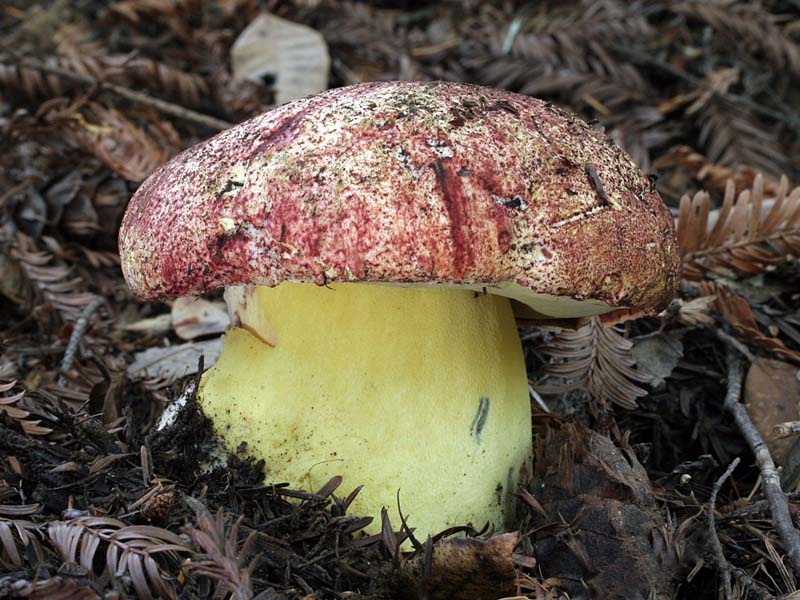


The stem is usually lighter than the cap or repeats its color. The characteristic features of the boletus are a mesh pattern and a dry surface. You can see the details of the appearance in the photo.
Structure and species differences
The fruiting body consists of a cap and a stem. The body is dense, massive. The hat has a rounded shape, sometimes cushion-shaped. The surface is dry, often cracked. The surface of the cap can be smooth or velvety, depending on the species.
The leg is strong and thick. It is always thickened at the bottom or in the middle. In almost all species, a mesh pattern is located on the stem, and only a few have a smooth surface. The structure of the stem is fibrous.

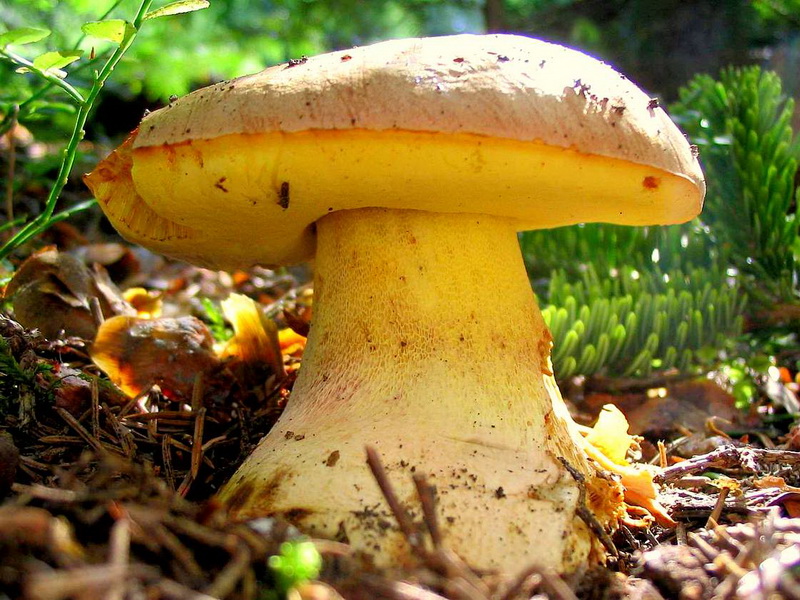



The flesh is firm and thick. Has a white or yellowish tint. For many representatives, it turns blue at the cut. There are species with reddening pulp at the break. The hymenophore is tubular. The tubes are held loosely or semi-loosely. The pores are yellow or reddish, and only a few are white. Spore powder is presented in shades of brown.
The difference between the very popular porcini mushroom and the rest of the Borovikov genus lies in the following aspects:
- The white mushroom hat is large in size.
- Its flesh tastes sweet and smells like toasted nuts.
- The mushroom belongs to the First category of edibility.





This mushroom is also otherwise called Borovik. This name is due to the fact that the White species belongs to the genus Borovikov and one name includes another. In fact, he is also a boletus, but has individual species differences.
Place of distribution
The fungus is distributed throughout the globe. It is not, perhaps, only in hot regions and in the lands of permafrost. It grows in places like this:
- coniferous forests;
- deciduous forests;
- mixed forests.
The white species prefers old forest stands. Representatives grow both singly and in groups.
This mushroom is distributed almost all over the world, except Australia. On the territory of Russia, it can be found up to the forests of Kamchatka.
Edibility
If we take into account the whole genus, then it is impossible to answer the question whether its representatives are edible or not. Most of the species are classified as edible
Moreover, 5 of them fall into the First category, which indicates a high nutritional value. But there are several types that belong to the inedible and conditionally edible category. And three members of the genus are considered toxic at all.
White mushroom
The cap is hemispherical or pillow-shaped, convex, fleshy. The surface is smooth, slightly velvety. The shade of the cap depends on the place of growth. Instances grown in sunny glades have a dark brown surface, while mushrooms that grew under the shade of trees have almost white caps.

The leg is massive, has a cylindrical shape, widened at the base. She has a whitish or light coffee color. A light mesh pattern is clearly visible at the top. The pulp is firm, thick. It is white in cross-section and does not change color in air. The smell of roasted nuts comes from the pulp. It tastes sweet.
The tubules of young mushrooms are white. In adults, they take on a yellow-green hue. Spore Olive Powder colors.
Birch
Popularly called Kolosovik. The hat is initially cushion-shaped, but flattens over time. The surface is smooth and shiny. In large specimens, it wrinkles slightly. The color of the cap varies in the following shades:
- whitish ocher;
- light yellow;
- gray-white.

The leg is barrel-shaped. Most often it is white and brown. A white mesh is visualized from above. The pulp is dense, white. When cut, its color does not change. The pulp does not have a pronounced taste. It gives off a faint mushroom aroma.
Boletus bicolor (Boletus bicolor)
Synonyms:
- Bolette two-color
- Ceriomyces bicolor
This type of mushroom is considered edible. So, in the process of mushroom maturation, the cap changes its original convex shape to a more open one.
The film of boletus bicolor has a pronounced color, namely, deep pink-red.
In the section, the mushroom pulp is yellow, in the places where the cut was made - a bluish tint.
The stem of the mushroom is also pinkish red.
The tubular layers that vainly hide under the cap are yellow.
Most of these mushrooms can be seen in North America during the warmth, that is, in the summer months.
The main thing when collecting is to pay attention to the fact that the edible boletus has a twin brother, which, unfortunately, is inedible. So be extremely careful
The only difference is the color of the cap - it is less saturated.
An interesting fact is that the boletus bicolor is also called a boletus, since it is a family of boletuses, but it is used extremely rarely.
In most cases, boletus bicolor is called nothing more than a porcini mushroom. By the way, mushrooms can also be attributed to boletus.
This mushroom can be found in coniferous and deciduous forests.
Similar species
Not all mushrooms of this type are edible.
Those types of mushrooms that can be eaten are often used in cooking, as they bring nutritional value to our body and give food a unique nutty taste.
It is surprising that if you cook the broth with mushrooms, then it will be much higher in calories than if you cook it with meat.
You can also take into account the fact that dried mushrooms are much more valuable in terms of energy food than ordinary chicken eggs, twice.
Poisonous Boletus is inedible. This double is distinguished by a hat with a less saturated color. Boletus pink-purple. Boletus pink-purple differs from Bolet two-colored pulp, which quickly darkens after damage and after a while acquires a wine tint. In addition, its pulp has an unsaturated fruity aroma with sour notes and a sweetish aftertaste. Edible Pine mushroom differs from Boletus two-color in that it has a brown, chunky plump leg and a bumpy cap, painted in a red-brown or red-brown tone. It only grows under pine trees.
Hostesses, please note that these mushrooms are not picky at all: they can be boiled, stewed, fried, as well as pickled, and they can always diversify your table and delight your loved ones with the taste





